Lurking in the halls of Buddhist temples and museums across Japan are a host of monster mummies -- the preserved remains of demons, mermaids, kappa, tengu, raijū, and even human monks. Here are a few remarkable specimens for the adventurous and brave at heart.
- Demon mummies
It might seem odd that Buddhist temples in Japan house the occasional stray mummified demon (oni), but then again it probably makes sense to keep them off the streets and under the watchful eye of a priest.
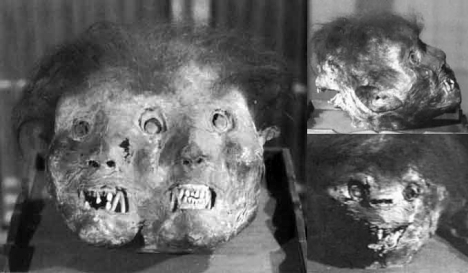
Three-faced demon head at Zengyōji temple [Photos]
Zengyōji (善行寺) temple in the city of Kanazawa (Ishikawa prefecture) is home to the mummified head of a three-faced demon. Legend has it that a resident priest discovered the mummy in a temple storage chamber in the early 18th century. Imagine his surprise.
Nobody knows where the demon head came from, nor how or why it ended up in storage.
The mummified head has two overlapping faces up front, with another one (resembling that of a kappa) situated in back. The temple puts the head on public display each year around the spring equinox.
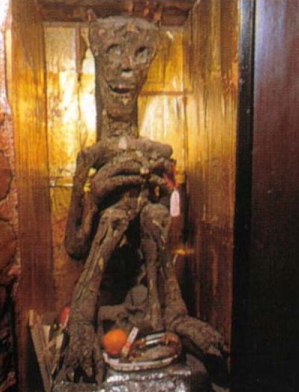 Another mysterious demon mummy can be found at Daijōin temple in the town of Usa (Oita prefecture).
Another mysterious demon mummy can be found at Daijōin temple in the town of Usa (Oita prefecture).
The mummy is said to have once been the treasured heirloom of a noble family. But after suffering some sort of misfortune, the family was forced to get rid of it.
The demon mummy changed owners several times before ending up in the hands of a Daijōin temple parishioner in 1925. After the parishioner fell extremely ill, the mummy was suspected of being cursed.
The parishioner quickly recovered from his illness after the mummy was placed in the care of the temple. It has remained there ever since. Today the enshrined demon mummy of Daijōin temple is revered as a sacred object.
A much smaller mummy -- said to be that of a baby demon -- was once in the possession of Rakanji Temple at Yabakei (Oita prefecture).
Unfortunately, it was destroyed in a fire in 1943.
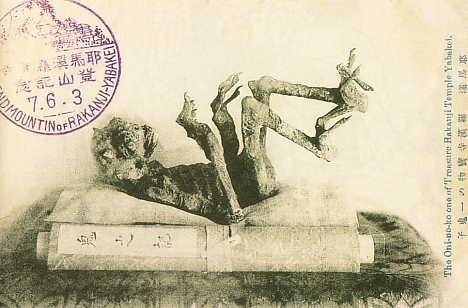
Baby demon mummy at Rakanji temple
* * * * *
- Mermaid mummies
In Edo-period Japan -- particularly in the 18th and 19th centuries -- mermaid mummies were a common sight at popular sideshow carnivals called misemono. Over time, the practice of mermaid mummification blossomed into an art form as fishermen perfected techniques for stitching the heads and upper bodies of monkeys onto the bodies of fish.
The mummy pictured below is a prime example of a carnival mermaid. It appears to consists of fish and other animal parts held together with string and paper.
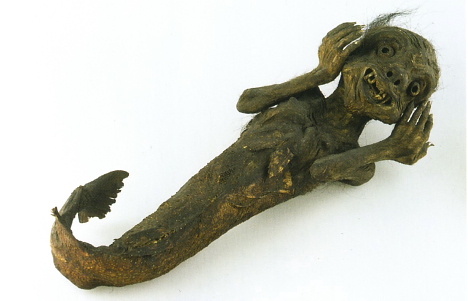
Mermaid mummy at the National Museum of Ethnology, Leiden
The mummified creature was obtained by Jan Cock Blomhoff while serving as director of Dejima, the Dutch trading colony at Nagasaki harbor, from 1817 to 1824. It now resides at the National Museum of Ethnology in Leiden.
Another old mermaid mummy exhibited at a museum in Tokyo several years ago appears to belong to the founder of the Harano Agricultural Museum.
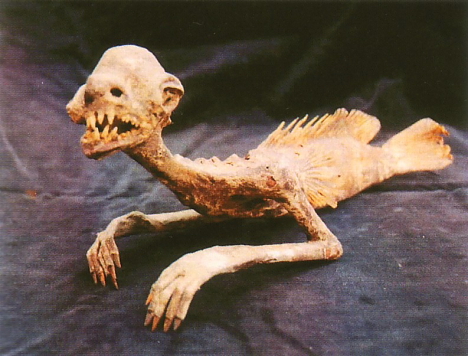
Mysterious mermaid mummy
The mummy's origin is unknown, but the collector says it was found in a wooden box that contained passages from a Buddhist sutra written in Sanskrit. Also in the box was a photograph of the mermaid and a note claiming it belonged to a man from Wakayama prefecture.
* * * * *
- Kappa mummies
Like the mermaid mummies, many kappa (river imp) mummies are thought to have been crafted by Edo-period artists using parts of animals ranging from monkeys and owls to stingrays.
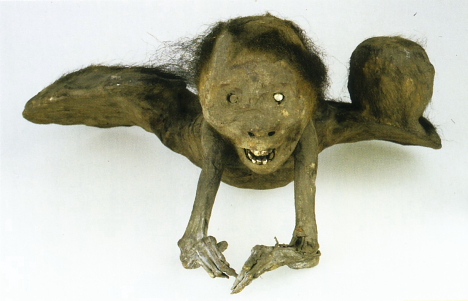
Kappa mummy at the National Museum of Ethnology, Leiden (Netherlands)
This mummified kappa, which now resides in a Dutch museum, appears to consist of various animal parts put together in a seamless whole. It is believed to have been created for the purpose of carnival entertainment in the Edo period.
Another mummified kappa can be found at Zuiryūji temple in Osaka.
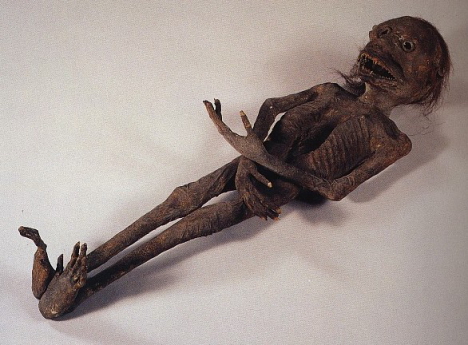
Kappa mummy at Zuiryūji Temple, Osaka [Photo]
The 70-centimeter long humanoid purportedly dates back to 1682.
Another notable kappa mummy can be seen in a seemingly unlikely place -- at a sake brewery in the town of Imari (Saga prefecture).
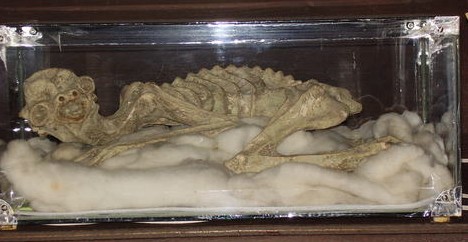
Kappa mummy at Matsuura Brewery
According to a company brochure, the mummified kappa was discovered inside a wooden box that carpenters found hidden in the ceiling when replacing the roof over 50 years ago.
Reckoning the creature was an old curiosity their ancestors had passed down for generations, the company owners built a small altar and enshrined the kappa mummy as a river god.
>>> Read more about the kappa.
* * * * *
- Raijū
With a limited scientific understanding of the sky above, the common person in Edo-period Japan looked upward with great awe and mystery. Supernatural creatures called raijū (雷獣) -- lit. "thunder beast" -- were believed to inhabit rain clouds and occasionally fall to earth during lightning strikes.
The earliest known written records of the raijū date as far back as the late 18th century, though the creature appears to borrow characteristics from the nue -- a cloud-dwelling, illness-inducing chimera first described in The Tale of the Heike, a 12th-century historical epic.
Details about the raijū's appearance vary. Some Edo-period documents claim the raijū resembled a squirrel, cat or weasel, while others describe it as being shaped more like a crab or seahorse.
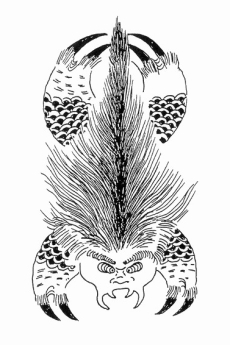
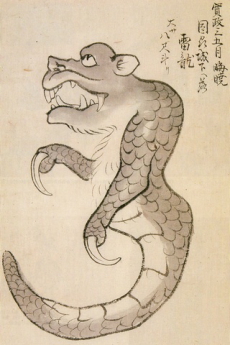
Raijū depicted in the Kanda-Jihitsu (ca. 1800) // Raijū seen in Tottori, 1791
However, most descriptions agree that the raijū had webbed fingers, sharp claws, and long fangs that, by some accounts, could shoot lightning. The beast also sometimes appeared with six legs and/or three tails, suggesting the ability to shape-shift.
One illustrated document tells of a raijū that fell from the sky during a violent storm on the night of June 15, 1796 in Higo-kuni (present-day Kumamoto prefecture).
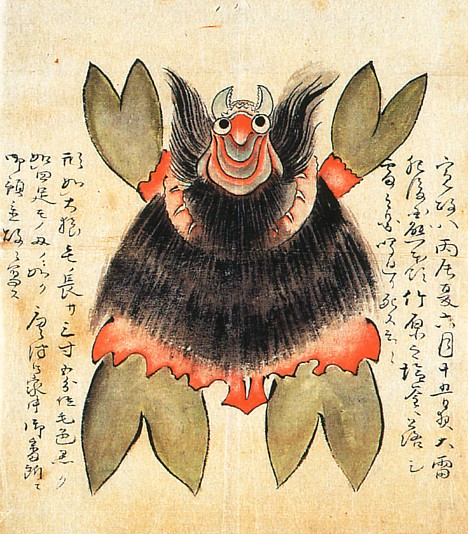
Illustration of raijū encountered on June 15, 1796
Here, the raijū is described as a crab-like creature with a coat of black fur measuring about 11 centimeters (4 inches) thick.
Another notorious encounter took place in the Tsukiji area of Edo on August 17, 1823. Two versions of the incident offer different descriptions of the beast.
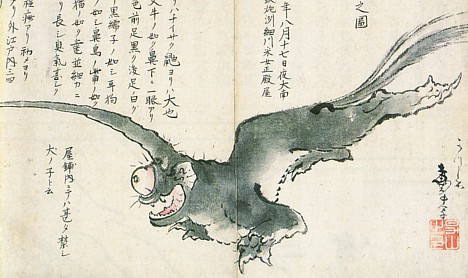
Raijū encounter, August 17, 1823 - Version 1
One document depicts the raijū as being the size of a cat or weasel, with one big bulging eye and a single long horn, like that of a bull or rhino, projecting forward from the top of its head.
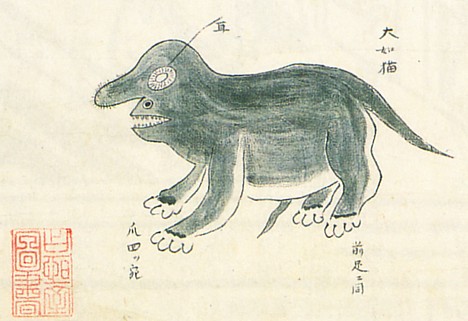
Raijū encounter, August 17, 1823 - Version 2
In the other account, the raijū has a more roundish look and lacks the pointy horn.
In Volume 2 of Kasshi Yawa ("Tales of the Night of the Rat"), a series of essays depicting ordinary life in Edo, author Matsuura Seizan writes that it was not uncommon for cat-like creatures to fall from the sky during thunderstorms. The volume includes the story of a family who boiled and ate one such creature after it crashed down onto their roof.
Given the frequency of raijū sightings, it should come as no surprise that a few mummies have turned up.
In the 1960s, Yūzanji temple in Iwate prefecture received a raijū mummy as a gift from a parishioner. The origin of the mummy, as well as how the parishioner obtained it, is a mystery.
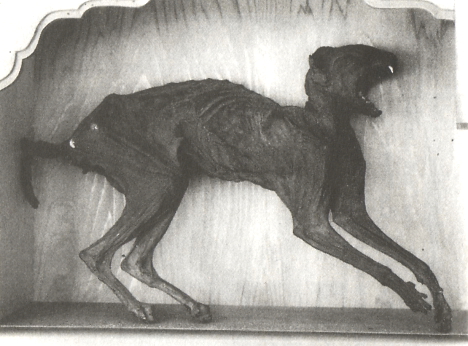
Raijū mummy at Yūzanji temple
The mummy looks like that of a cat at first glance, but the legs are rather long and the skull has no visible eye sockets.
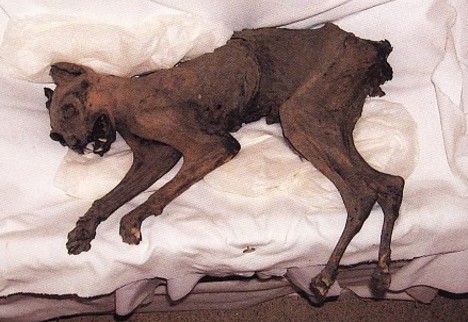
Raijū mummy at Saishōji temple [Photo]
A similar raijū mummy is on display at Saishōji temple in Niigata prefecture.
* * * * *
- Tengu mummy
Another legendary supernatural sky creature is the tengu, a dangerous demon often depicted in art as being part human and part bird. The Hachinohe Museum (Aomori prefecture) in northern Japan is home to a tengu mummy, which is said to have once belonged to Nambu Nobuyori, a Nambu clan leader who ruled the Hachinohe domain in the mid-18th century.
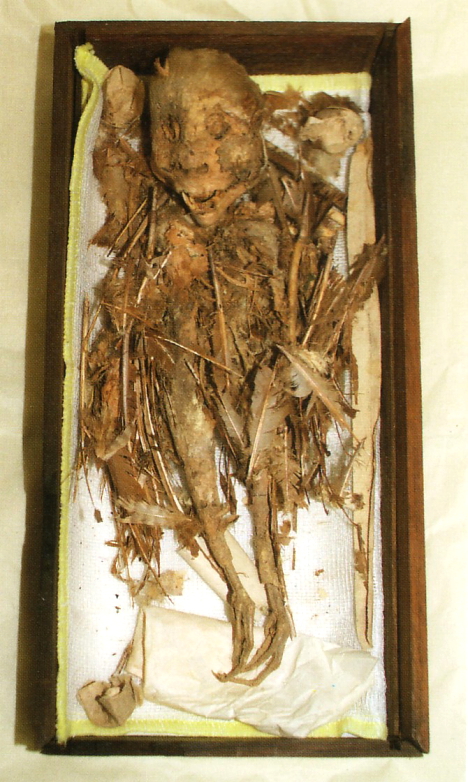
Tengu mummy at Hachinohe Museum
The mummy, which appears to have a humanoid head and the feathers and feet of a bird, is believed to have originated in the town of Nobeoka (Miyazaki prefecture) in southern Japan. Theories suggest the tengu mummy made its way north after being passed around between members of Japan's ruling samurai families, some of whom were deeply interested in collecting and trading these curiosities.
* * * * *
- Self-mummified monks
A few Buddhist temples in northern Japan are home to "living mummies" known as sokushinbutsu (即身仏). The preserved bodies are purportedly those of ascetic monks who willingly mummified themselves in the quest for nirvana.
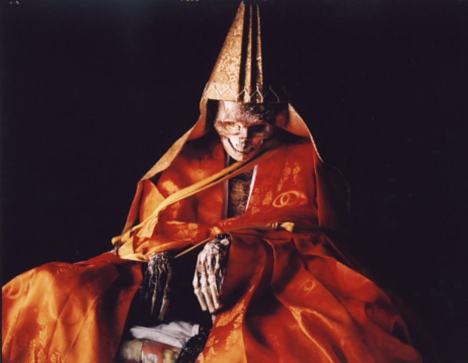
Shinnyokai-Shonin "living mummy" at Dainichibo Temple (Yamagata prefecture)
To become a living mummy, monks had to undergo a long and grueling three-step process.
Step 1: For 1,000 days, the monks would eat a special diet of nuts and seeds, and engage in rigorous physical training to strip the body of fat.
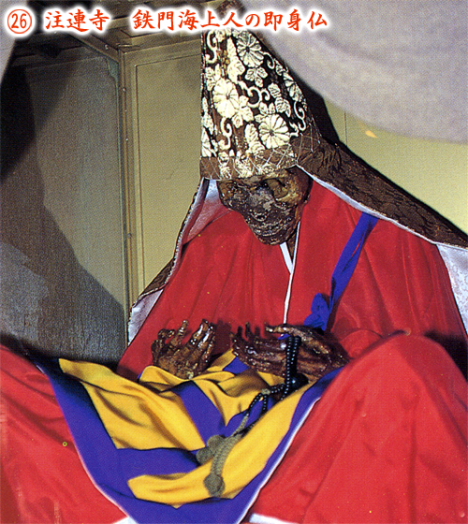
Tetsumonkai-Shonin "living mummy" at Churenji temple (Yamagata prefecture)
Step 2: For another 1,000 days, they would eat only bark and roots in gradually diminishing amounts. Toward the end, they would start drinking tea made from the sap of the urushi tree, a poisonous substance normally used to make Japanese lacquer bowls, which caused further loss of bodily fluid. The tea was brewed with water from a sacred spring at Mt. Yudono, which is now known to contain a high level of arsenic. The concoction created a germ-free environment within the body and helped preserve whatever meat was left on the bone.
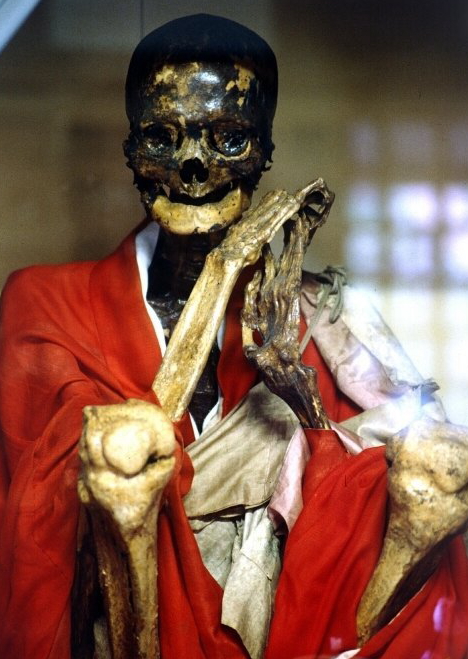
Arisada Hōin, 300-yr-old "living mummy" at Kanshūji temple (Fukushima)
Step 3: Finally, the monks would retreat to a cramped underground chamber connected to the surface by a tiny bamboo air pipe. There, they would meditate until dying, at which point they were sealed in their tomb. After 1,000 days, they were dug up and cleaned. If the body remained well-preserved, the monk was deemed a living mummy.
Unfortunately, most who attempted self-mummification were unsuccessful, but the few who succeeded achieved Buddha status and were enshrined at temples. As many as two dozen of these living mummies are in the care of temples in northern Honshu.
The Japanese government outlawed the practice of self-mummification in the late 19th century.

Timothy
This just gave me nightmares.
[]Bastel
lolwuttwat
[]Erick
Were do you think Godzila came from?
[]Kurt
in your mouth... haha...!!
[]Catherine
**FROM your mouth.
[]Kurt
hopefully Barrack Obama will being mummified after his death... haha...
[]bruce
Fabulous... Although monsters have disappeared from the Western psyche we still have the supernatural. Great post. thanks
[]Jeff
Yeah..... Nice way to waste time and energy. Nobody takes this seriously do they??
[]Bob
Seriously, we should all just take Jeff seriously instead. Did you see the way he outed a fascinating, innovative, and provocative form of ancient art? So smoothe.
[]Angel Mass
Those Mermaids sure doesnt looks like Ariel
[]elena
LOL!!!
[]elena
how the fck did this turn into talking about fcking obama and sh!t!? wtf people!? stfu!
[]Rick Mikos
I, I never would have believed it if I didnt see it myself. I have been to Japan and these are for real. There are fakes but most of these are not.
[]m. heart
wow. one more reason to go to japan - these are awesome. great post.
[]MR
I agree, wether or not there is truth in any of it is beside the point. Just to see the things people did for entertainment and for their belief back then is amazing and interesting.
[]torchy
yes, precisely.
[]nick
Its pretty crazy that people concieved of these "monsters" and then went ahead and created them using a variety of animals and humans. And for profit no less at places like the carnival. Morbid yet amazing.
[]project whiskey echo echo delta
Brutal, will you accept the three thousand day mummy challenge?
[]your reward? Nirvana!....but i hate kurt cobain
NIRVANA FAN
Then you like Justin Bieber
[]Kelly
i think that ancient civilizations were playing with DNA. We are not here for the first time. No, we have been here many times before. Perhaps, wHat we are looking at on this site is the failed experiments of ancient mad scientists.. Much like what is happening today....
[]tom
u r very dumb
[]Emmy
I don't think that's dumb, I think it's quite genious!
[]I would never had thougt about it
MR
of course you would think that a thought like that would be dumb. Your probably a self centered close minded lazy fuck who believes that todays knowledge and technology is everything. I personally agree with the far fetched possibility considering how old this planet is how far back our human records only go... we really have no idea who we all as humans use to be or how we lived before what we know. Our past holds more theory than fact.
[]Morgan
Scientists have done studies showing that the out of africa theory is correct. Even if you try and say we were tampered with in our developement, it would have been in Africa. Also there are lots of transitional fossils to counter that arguement.
The original guy was obviously wrong, and quite dumb to think that these obvious fakes are the result of genetic engineering of aliens.
I believe in the possibility of aliens, even their contact with earth, saying that they visited and tampered with us also has some evidence, none of that changes the fact that these are the hideous result of two animals being stitched together and preserved. The other ones are genetic anomalies, which crop up every now and then even today.(no aliens required)
[]Virtumonde
Very interesting images and some good comments. Japanese culture as a whole is interesting enough but when you add in stuff like this it's just hard to understand the mind set of some past cultures. Seriously who would want to make them self a living mummy.
Personally I do not but a whole lot of faith in the whole the world has been destroyed several times before but then again I can't disprove it and there are plenty of can't explain artifacts that do support such claims. Not to mention well known ancient cultures that had advanced knowledge of mathematics and what seems to be a very good understanding of astronomy.
[]Mr. A.
They wanted to make themselves a 'living mummy' because these were disciplined people. their lives are/were completely different than ours in what you'd no doubt perceive to be an alienistic way. This was the way of life they were born and bred into, and I don't know about you, but they TRULY believed in their beliefs. Do you know any one who would do some crazy shit like this if it wasn't something they had ABSOLUTE faith in? Get a dictionary and look up 'asceticism'. Their whole paradigm for life is literally the polar opposite of yours. While you seek to do things for yourself, improve your life, make it more beautiful, etc, they deny all things for self.
[]Mypenisisamummy
How could items such as gold chains and spark plugs inside solid coal be explained? Or 12,000 year old cities a mile beneath the ocean? HOw about fossilized human footprints over top of dinosaur footprints? Check out the 20000000 year old human footprint that it 3 ft long.
[]GSD
I think you meant to say 20 000 not 20 000 000
[]TooFunny
Many of these look like my family members.
[]Emmy
omg lol :D
[]Giselle
thats just mean and evil...>:(...lol luvv it!!!!so HILARIOUS!!
[]Dr. Cat Nipples
I want to make love to all of those mummies!
[]digg noob
MILF! lol
[]Emmy
that's just weird... u got to be whoever u want but still...that's not normal xD
[]Alexander Dombroff
Those are crazy! I can't believe they poisoned themselves trying to become mummies!
[]fswifpwf;skdf;sdkf
Wouldn't it be cool to have G W Bush mummified?
[]Emmy
oh god yes!!
[]or not...then he would kind of live forever xD
Nolan Hajanuke Stobinski
lets jus burn him then use his
[]ashes as kitty litter
Weirded out
I was more sick to my stomach by Dr. Cat Nipples response, then by the mummies! Still sickos around aren't there!
[]Irritated
And very dumb people with no sense of humour, yes.
[]Tony
Interesting stuff. Some look more real than others. Interesting that what they called demons look remarkably like what most people today would call aliens.
[]Emmy
interesting point of view
[]Mypenisisamummy
Or monkeys. Whichever term you prefer I guess
[]ARCANE12
Some are real and most are fakes, but all are nightmares!
[]rush
what kind of left-wing ignorant point are you trying to make
why don't you get over the President Bush thing
he saved this country you moron
[]mark
To the person who said George Bush saved the country. George Bush caused 911 through his negligence. He ignored the CIA note that was placed on his desk and which Condoleeza Rice admits receiving. Then he instituted terrorism and degradation against his own citizens at airports and public buidings. The only thing Mr. Bush and Cheney did was get drunk in the Whitehouse. Cheney shot a man. (He had two prior DWI's.) Bush fell of a couch and got a black eye while watching football "by himself." Then he fell off his bicycle while bicycling with his "Doctor." (One prio DWI for Bush) Oh, yeah, they also bankrupted the U.S. in two wars which we will probably lose.
[]Nathan
Well, Obama has already put Bush to shame with all his half-wit initiatives.
[]Kylie Jean
Somebodies got their panties in a bunch.
[]Emmy
he's got alzheimers, u know plus he cheated on the election
[]not the brightest choice for a president
Otaku Dreamer
Saved us from what, "Rush", mummies? If he saved us from anything, that is the most likely. Everything else led to the 4 Ds, debt, disaster, death and destruction.
[]anon
^^^
it appears this blog has been flooded by digg noobs
[]Veritas Aperio
It's funny, but these mummy images just make me hungry for ribs and chicken wings.
What kind of barbecue sauce would someone suggest? Spicy? Hickory smoked?
[]Irritated
Teriyaki surely.
[]Dolly
The mummies remind me of Mexico's Chupacabra's. Spiritual manifestations of human thought turned physical. So glad these have been preserved!
[]Emmy
yeah, I feel the exact same way!
[]oA
.
are these real? hmmm
.
[]Savi
The living mummies are incredible. It is my understanding that those who attempted this task were intending to become sources of inspiration for those seeking enlightenment. I'm sure that was just one of a number of intentions.
[]For those that were successful, their efforts were impeccable. What a feat! That level of self-discipline is nothing to shake a stick at. I find it honorable in the extreme.
Emmy
japanese people ftw
[]Kylie Jean
I agree with your big words.
[]Mummy Hater
You people make me sick...
[]Dee
To Mummy Hater
[]If you didn't like them why did you look at them, no one twisted your arm or did they??
m c pee pants
I just pooped in my pants and threw it at my mom!
[]Emmy
interesting...
[]Nolan Hajanuke Stobinski
who the hell let u on peehead
[]Worldly Today
That last one is really creepy you can almost make out what she'd look like.
[]live forever
Err yer 'she' almost looks like a man, or maybe 'she' was a man OMG!
[]Japanese@Heart
Female monks do not, and never did exist. All three of those sokushinbutsu are male.
[]Joey
Man, what an interesting site!! Great work! Im lost for words. Man can be such an intelligent creature, and a times, bizarre is all I can think of... God help us all
[]bary bennett
GREAT JOB MUMMY GUYS, I'M GONNA RUN RIGHT OUT AND PURCHASE SOME SAP TREES AND ARSENIC WATER AND PROCEED TO EAT MY WAY TO NIRVANA
[]BUT I'M GOING TO PUT SOME SUGAR ON IT FOR TASTE.CAN I WEAR LEVIS AND A PLAIN WHITE TEE SHIRT INSTEAD OF THOSE RATHER GAUDY OUTFITS? DID I MENTION I WAS BAPTIST?
out there somewhere
hahahahahahahah
[]Mike
"Hey, Professor, great jerky!" Phillip J Fry
[]Nathan
I was waiting for the Futurama reference!
[]Clint
Living mummy.I would live to meet one of these guys before they start the process and see what makes them tic. I do not ever want to do anything like this. I would think it would be a bad life choice.
[]Allie
The monks are the creepiest to me, it's incredible what some people can do in the name of their beliefs.
[]???
Are these examples of failed DNA tweaking by our own alien ancestors?
[]undisclosed
Very likely these are failed experiments of alien abductors. There are even indications that the creators of these "mummies" have bred these horrible creatures as pets - look at their poses!
[]Everlasting Truth
In the bible it says, the end times would be as the days of Noah. It seems probable that pre-flood was a time of great knowledge that resulted in some beings messing with genetics. Unfortunately with zero humility, no moral constraint, no love for humanity and a total disrespect for Gods creation. Yet, God did not give up on man, nor did man give up on God. And here we are today, with great knowledge unfolding, so what do we do with it? I feel a profound sense of gratitude, for the beauty of Gods creation. And a concern that in a very real sense, we must draw from this understanding a practical wisdom. The greatest gift is love, and I think Jesus knew all about this, he was no dummy ( I mean mummy )!
[]Fenix
Do not give me this bible thumper hooey. When you read your bible, where does it come from? Off a printing pres. Who put it on the printing press? some guy at a computer. So you can walk up and down all day with your sign proclaiming th laws of god, as written by god. But I know my history. I know man has been dinking around with the so-called "Word of God" for thousands of years, since before Jesus was born. Remmeber that the next time you're sitting odwn in church on Sunday. You're only listening to a human being. You want God? Take a walk in the oods by yourself.
[]Nathan
We have had computers for thousands of years?? Weird... Perhaps it can be traced a little further back than the guy at the computer.
[]Solo
BUT ANYWAYS.... --What was I gonna say to this young fella name Fenix...-- Yes. Are you Atheist? -trolololl- ...I'm just kidding, please don't take it seriously. But if you are then my apologize. ~But STILL, dude/ma'am/ or whoever you are, don't be talking all those printing/computer shit to them! That's not the point there.
[]To be straightforward, shut your damn mouth up and watch your attitude. I'm glad you know your history, but don't be spilling it! We all know all our history.. But sadly, most of your shit are false. You don't really know the book Holy Bible came from. Honestly, I don't know, people don't know, especially You don't know where it came from--admit it! It is prohibited to talk about that book, so stop it. ~Next time, you should best not to speak about this anymore. I'm not preaching nor lecturing! Just telling, 'cause, you see, you're gonna get yourself embarrass--totally embarrass someday. Or worse, get yourself killed. Though, I'm afraid the "killing" part won't happen at all to you...if you watch what you speak!
Who? Me?
Hello, just about the comments of the christians here or the one type something about 'Jesus' if u call that ur faith first of all why should god make him suffer his been good no? Second why son of god and not daughter isn't it suppose to be equal? Here we r and see that many things are a lie and just to twist people all the way from back in time i'm not saying that things in the bible are all wrong but most of them truly are :) just think about those facts i was pointing at and by the way there just a few!!! There is another strongest religion but u guys won't tell not now,... when time is right now just guess or laugh or comment whatever all u do most of the times is talk about noncense anyway. And these mummy thing and creature do excist if the most showen r made copys or made by humans, know that there excisted and still excist more than showen here!!! Some more cruel and scary far away than these here. Don't think that u people r living in a futuristic more composed time than 10000 times before (ok it is true) but doesn't mean what was showen in ancient time and what excisted is fals everything is possible this is world and what lived or looked like before was extremer! Why u think its just normal that true time people gave angels wings and demons goats legs? Well final point u and we can believe whatever we like up to u and us :)
[]Izzy
I make remarks as a Japanese.
[]Sokushinbutsu is immediately a real thing.
Old North Japan was very a deprived neighbourhood.
They believed that he immediately became Sokushinbutsu and the villager survived.
Their self-sacrificing spirit are worth the respect.
They are not fanatics.
Others' lives are more important than my life. It is an embodiment of the idea of Japan from old.
RNFR
so they mummified themselves so others in their poor region could have food to eat? now, that is truly amazing. i don't know of any christians that have done that lately.
maybe those that don't understand should think a bit deeper before they judge, eh?
[]Karol
POKEMON mummies
[]Emmy
wanna see!!
[]thejapaneseeye
This was a extremely interesting post backed with amazing photographs
[]BruceCaneCurler
Amazing photographs? How about absurd fakery using spliced fetus parts and animal carcasses.
See SkepticalInquirer.com
[]Scott
nothing is more tedious and less entertaining than a skeptic....
[]except a skeptic lacking a sense of humor
Luna Johannson
I think I'm going to have nightmares after seeing this . . . Especially the self-mummification part. *Shudders*
[]Made in DNA
damn, that's just down the street. gonna have to make a day trip some time soon. thanks.
[]Jymmay
Hellooooo Tengu Mummy! Drenching yourself in feathers is sooooo 2000 years ago!
[]The Irate Pirate
So you don't think any christian monks would mummify themselves?
Ever heard of the Capuchin's Catacombs in Palermo, Sicily?
http://members.tripod.com/~Motomom/index-3.html
artist Alex Grey also did some preserving of mythic-looking fetuses when he worked in a morgue. that was before he slept with a corpse for performance art, which led to him being put on trial in a dream, by the dead woman's spirit, which led to him focusing on painting only light-filled things afterwards, which is how he is known.
[]Flu-Bird
Where will the remains of GODZILLA be found?
[]Lewis Field
Poor pagan fools. The crusty, earthly remains of dead humans, creatures, and plant matter are worshiped by idiots like they're gods, while the souls of living and deceased linger in hell. Sad, weird, and oh so human. Interesting in a clinical sense, of course.
[]Apparently pagan
Uh, those same pathetic pagan people are the same people who created your computer.
[]indie
o_O
[]African queen
hmmm, interesting but are they real!!!!!!!!!
[]Monique
Magnific o__o
[]someone
thanks god
[]its work for me
i'm in diet
Brinticus
Why not just submit the DNA of some of these preserved mummies and figure out what the hoax is? It's not like we couldn't easily tell what's going on here, even if the earlier people were clueless.
[]fishy
Exactly. I want DNA test results for these things. :/
(I guess it's possible that a few are "sort of" real- like, extinct animals or known animals that were born mutated.)
You'd have to get DNA from several points on the corpses, though, since a lot of these are pieced-together art projects. >_<;
[]hannah
wow another creepy reason to go to japan
[]NICK
DANM RGHT
[]yokai lover
i love yokai ! cool ! i feel sorta bad for them tho . poor kappa poor tengu ! but that one other mummy looks like an alterd cat.
[]BOB
kurwa ale ci japonce maja najebane we ?bach ;D
[]CAPTAIN OBVIOUS
[Reply]
"Are these examples of failed DNA tweaking by our own alien ancestors?"
No, they are known to be parts sewn and glued together.
"Why not just submit the DNA of some of these preserved mummies and figure out what the hoax is? It’s not like we couldn’t easily tell what’s going on here, even if the earlier people were clueless."
The sokushinbutsu are not a "hoax." They really did this. Lots of people in history have done weird and horrible things in the name of religion. No, they are not a hoax. What, you can accept mermaids, but not religious people who die?
To the "hate Bush" people: do not DARE say Bush cost us money. Obama has spent more money in a couple of months than any other President in US history, so you are WRONG WRONG WRONG. $3 trillion to "stimulate the economy" by "making cars more fuel efficient in ten years." How the hell does that help any poor people, you idiotic moronic liberals?
[]chobits!
my god!what a terrific monzters????it doesn't make any sense...what about the fakery!????NIGHTMARES????that's hilarious!
[]Mr. Me
The living mummy things is awesome. And anyone who thinks those monks aren't awesome, needs to find a dictionary and look up the word "awesome".
Actually, the living mummy thing almost happened to me. Only instead of nuts and tree bark, it was ritz crackers, cheese, and diet coke. And instead of being in a cave, I was in my room. And instead of meditating, I was playing World of Warcraft.
Luckily, just after 2000 days, the power company cut my electric supply and I had to go and get a job.
I say "luckily" only because I don't think any modern Japanese temple would have taken me in and cared for me after they found my perfectly preserved body.
Anyways... to address some things brought up in the posts:
Did such strange creatures exist?
-Yes, in the folds of history many strange creatures did exist, like sloths the size of elephants. No, these creatures almost certainly did not. Old Japan just had a phase of making these things, just like modern high school girls are in a phase of starving themselves to near death and christian homosexuals are having a phase of going through electroshock therapy to treat their almost certainly genetic disposition. It's only completely insane when taken from an outside perspective.
And to set facts straight,
Bushes war cost us around 650 billion, most of which was spent on stuff made outside of America, and much of which was blown up. (And that 650 billion was just a fraction of his overall spending). In terms of amount, I'm sure he'll spend less than Obama, but Obama will at least spend his cash mostly in the U.S. to promote U.S. infrastructure (not tear down Iraqi infrastructure).
I agree he shouldn't spend so much, and that the government needs to stop supporting big corporations like GMC, that can't support themselves. Let them die, so newer better run businesses can take their place. But let's not lie to ourselves and say that Bushes policies were any different.
[]Bob
YAAWWWWWWWWWWWWWWNNNNNNNNNNNNN!!!!!!!!!!!!!!
[]Big Joe
It's sad when dead mummies become political bs talk and as with the mummies the facts are left out as well.
[]Delta White Pictures
I saw something about that on TV last night Check out about Delta White Pictures
[]Nobody
Awesome post & great collection of images! I don't really care if the yokai mummies are real or not, they're still interresting regardless. I think my faves are the 3-faced demon, raijuu & the "living mummies"...great stuff!
[]YoBro
Give me a hug bro.
[]Dave in San Diego
You, sir, are a fuckwit.
[]Raven
Thank you for honoring the past, American's seem to cast away their old and have no respect for their ancestors. This was a great gift of photos and History of Japan. As for the monks imagine what sacrifice that took, truly the were enlightened.
[]Emmy
wonderful info!
[]i'm working on a project and this really helped me a lot :)
Kenny
TOday is Anzac day in Australia and even overseas (Japan)
I pay tribute to these mummies who sacfrificed for us. Espeically living mummy.
They shall not grow old, as we that are left grow old:
Age shall not weary them, nor the years condemn.
At the going down of the sun and in the morning,
We will remember them.
Lest we forget!
[]Asher Kade
I really liked these pics. Woould you mind me using them in an article I am doing for Environmental Grafitti? I am compensated, and would link you, your work, and your site to the phtos.PLease let me know asap. asher_kade@yahoo.com.
[]sanju
mind blowing dud this is only i am finding in the net.....
[]seriously such a nice job....
dreamer
There is still belief in such things in japan today. Japans history is so full of culture and imagination. the oni , mermaids etc are amazing to see even if man made it is something new and fresh for us westerners. and for the monks , I hope they found their nirvana
[]none
so fake
[]POEPJE
PRAAT NEDERLANDS OF ZO !!!!!!!!!!!!!!!!!!!!!!!!!!!!!!1
[]kai
real pokemon!
[]WassaZaki
There is a possibilty that these mummys could all be fake (besides the monks) because they could have been made by skilled crafters centuarys ago but still this is truly amazing.
[]CHRISTIAN BELIEVER
Ummmmm when I see this in the real world..they only have one type of mummie but coming into JAPAN ohh myy life..uh this is kinda dumb...hey they should atleast throw them out and that is why freaking baaaad spirits are coming down to earth!!!!! for freakin sakes people!!!!
[]AShley Kravitz
i am currently working on a motion picture and we want to use an image that appears on your site (the Kappa Mummies image) and i would like to know who owns the rights to the photo so that we can obtain the proper approval. Any assistance is greatly appreciated.
Ashley Kravitz
[]marc
i would like to know more
[]Sarah&alicia
You would like to know more eh? WELL ILL TELL YA. this is a god damn fucking load of bullllshit. the only person i agree with on this entire fake piece of crap websire is dr. cat nipples...SUCK MAH BALLLS MR GARRISON...................fuck y'all losers.
[]anonomous
i know a top secret wax mummification process which keeps you preserved forevetr. not e traditional mummy, but the exact same thing you looked like when you were alive, like a wax sculpture.
[]To y'all noobs...jk
Dayum! Some of you people say it's fake, well didn't you even read the whole article? No shit, almost all of them are real, but the others were created into many different kinds of animal or other creature parts( so it's mostly like 'fake', lol, but it's still creative and give them a thumbs up, will'ya?). Anyway, sorry, I just had to shout out at that. --By the way, what I was going to say... This demon mummification article gave the mega creeps outta me! O.O Especially, the mermaid mummies (which was kinda awesome though..xP) and the three-faced demons...=.= -pukes- That, I feel disturbed, for some odd freaking reason. >.> And enough of that monk mummy thing. Ughh...How sick they are and such unsuccessful failures(most of them). lol. ---- And please, don't take this as offensive or any other shit you're thinking there. Ty.
But yea still, I enjoyed reading this. Though it gave me the mega creeps. *_* -shivers- Now, like most people say, there's another damn reason why I WANNA GO TO JAPAN now! 8D Greatness... haha'. I cannot totally wait for it, bros! >8)
[]Lilly
In my opinion, these are strange creatures at the same time interesting. : - @ @
[]yazzie
that looks so fun to see a mumy
[]icarus
Props to the fishermen who made effort into stitching different animal parts. Nowadays, pranksters have it easy with Photoshop. Even if the mummies are fake, it's still an amazing hoax. I feel bad for the monks though, just as they finally reach nirvana, they die. Disciplined people such as them are greatly needed in this world.
[]GSD
Our past has been ruined BY OUR PRESENT!!!
[]GSD
WHo knows what this crazy world holds within... SAve the jungles and rainforests and all nature
[]Lai-Lai
The 3-faced demon looks like a lion with Diprosopus & an additional parasitic triplet, which might be sewn on & not even the same species.
The rest of the non human ones are all taxidermy arts & crafts.
[]